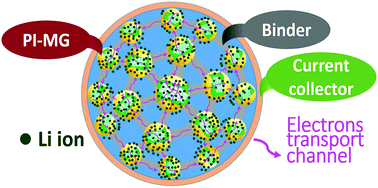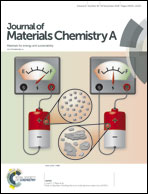Superlithiation of non-conductive polyimide toward high-performance lithium-ion batteries†
Abstract
Superlithiation has been observed in some carbonyl-based organic electrodes, which leads to very high battery capacity. However, as typical carbonyl polymers, polyimides (PIs) exhibited a relatively low capacity (≤250 mA h g−1) in previous studies because their poor electrical conductivity restricts superlithiation. Therefore, to realize superlithiation, in this study, multilayer graphene (MG) as a conductive additive was incorporated in PI matrix through a blending precipitation and thermal imidization method. As an electrode in lithium-ion batteries, PI–MG exhibited outstanding capacity (612 mA h g−1 at 100 mA g−1) and stable long-term cyclability (89.3% capacity retention over 500 cycles at 500 mA g−1). Moreover, the battery could be operated stably at various temperatures, and it exhibited very high specific capacity, especially at the high operating temperature of 55 °C (873 mA h g−1, 0.1C). We believe that this strategy of introducing conductive additives to promote superlithiation is highly applicable to other non-conductive carbonyl polymers for lithium-ion battery applications.



 Please wait while we load your content...
Please wait while we load your content...